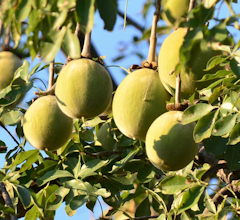Baobab
 Baobab belongs to the genus Adansonia, and there are nine species in this genus. Out of these, six are native to Madagascar. Other species are native to Africa, Arabian Peninsula, and one species is native to Australia. The Baobab plant is also widely grown in other parts of the world. Ancient travellers brought Baobab to India and other parts of Asia.1
Baobab belongs to the genus Adansonia, and there are nine species in this genus. Out of these, six are native to Madagascar. Other species are native to Africa, Arabian Peninsula, and one species is native to Australia. The Baobab plant is also widely grown in other parts of the world. Ancient travellers brought Baobab to India and other parts of Asia.1
The Baobab plant is particularly known for its longevity. Both the leaves and fruit of the Baobab are in used as food additives or remedies in various parts of the world. In western nations, people use Baobab leaves as a dried powder for health benefits. Modern science has started to study Baobab’s chemical constituents, and it has been found to be rich in various vitamins, minerals, high-quality fats, carbohydrates, and proteins. Baobab also contains many other beneficial phytochemicals including phytosterols, flavonoids, amino acids, fatty acids, and so on.2,3
Health Benefits of Baobab
- Rich Source of Vitamins and Minerals
Although various combinations of vitamins and minerals are widely available in developed nations, natural vitamin and mineral sources have better bioavailability and are present in a chemical form that can be readily utilised by the body. Baobab is naturally rich in Vitamin C, potassium, magnesium, zinc, iron, Vitamin B6, and niacin.4 - May Aid Weight Loss
Baobab can be included in a weight loss program as it may help in multiple ways. Studies show that 15 g of Baobab added to smoothies may help you to effectively satisfy your hunger. Baobab’s high fibre content may benefit gastrointestinal health. In addition, the vitamins and minerals contained in Baobab may help prevent deficiency of micronutrients in the body.5 - Help Control Glucose Levels in Those Living with Diabetes
Studies show that high dietary fibre intake is inversely related to the incidence of metabolic disorders and cardiovascular problems. Studies of Baobab show that it can modify the digestion of starch and therefore influence blood sugar levels. It may be particularly good at preventing post meal spikes in the blood glucose level, and therefore reducing the requirement for insulin by the body.6,7,8 - Reduces Inflammation and Prevents Cellular Damage
Baobab seems to be a potent antioxidant and good at lowering systemic inflammation. Low-grade systemic inflammation is known to cause worsening of various diseases like heart disorders, diabetes, dementia, and so on. Regular consumption of Baobab may help protect various organs from oxidative stress and reduce systemic inflammation.9 - Good for Digestive Health
Studies show that low consumption of dietary fibre is one of the leading causes of the high prevalence of metabolic disorders among people living in developed countries. Baobab powder is an excellent source of dietary fibre and therefore may help prevent a range of health conditions. It may help relieve constipation, promote the growth of beneficial bacteria in the gut, and reduce the risk of inflammatory bowel disease.10 - Help Reduce the Severity of Symptoms in Malaria
Malaria is a significant health hazard in some developing nations. Studies show that consumption of Baobab may help protect against certain strains of malaria, and slow down its progression.11
Side Effects of Baobab
Baobab leaves, seeds, and fruit are widely consumed as part of a regular diet in various countries in Africa and does not seem to have any severe side effects.
Properties
- Anti-Inflammatory9
- Cardiovascular Support6,7,8
- Constipation10
- Diabetes / Blood Sugar6,7,8
- Digestive Function10
- Heart Support / Health6,7,8
- High/Good Levels of B Vitamins4
- High/Good Levels of Carbohydrates2,3
- High/Good Levels of Fibre2,3
- High/Good Levels of Flavonoids2,3
- High/Good Levels of Iron2,3
- High/Good Levels of Magnesium2,3
- High/Good Levels of Niacin4
- High/Good Levels of Phytochemicals / Phytocompounds2,3
- High/Good Levels of Potassium4
- High/Good Levels of Protein2,3
- High/Good Levels of Vitamin C4
- High/Good Levels of Zinc4
- Malaria Support11
- Weight Loss / Management5
References
- https://www.britannica.com/plant/baobab-tree-genus
- De Caluwé E, Halamová K, Van Damme P. Baobab (Adansonia digitata L.): A Review of Traditional Uses, Phytochemistry and Pharmacology. In: African Natural Plant Products: New Discoveries and Challenges in Chemistry and Quality. Vol 1021. ACS Symposium Series. American Chemical Society; 2009:51-84. doi:10.1021/bk-2009-1021.ch004
- Rahul J, Jain MK, Singh SP, et al. Adansonia digitata L. (baobab): a review of traditional information and taxonomic description. Asian Pacific Journal of Tropical Biomedicine. 2015;5(1):79-84. doi:10.1016/S2221-1691(15)30174-X
- Bamalli Z, Mohammed AS, Ghazali HM, Karim R. Baobab Tree (Adansoniadigitata L) Parts: Nutrition, Applications in Food and Uses in Ethno-medicine – A Review. :9.
- Garvey R, Clegg M, Coe S. The acute effects of baobab fruit ( Adansonia digitata) on satiety in healthy adults. Nutr Health. 2017;23(2):83-86. doi:10.1177/0260106017704361
- Coe SA, Clegg M, Armengol M, Ryan L. The polyphenol-rich baobab fruit (Adansonia digitata L.) reduces starch digestion and glycemic response in humans. Nutr Res. 2013;33(11):888-896. doi:10.1016/j.nutres.2013.08.002
- Coe S, Ryan L. White bread enriched with polyphenol extracts shows no effect on glycemic response or satiety, yet may increase postprandial insulin economy in healthy participants. Nutr Res. 2016;36(2):193-200. doi:10.1016/j.nutres.2015.10.007
- Lattimer JM, Haub MD. Effects of Dietary Fiber and Its Components on Metabolic Health. Nutrients. 2010;2(12):1266-1289. doi:10.3390/nu2121266
- Ghoneim MAM, Hassan AI, Mahmoud MG, Asker MS. Protective Effect of Adansonia digitata against Isoproterenol-Induced Myocardial Injury in Rats. Anim Biotechnol. 2016;27(2):84-95. doi:10.1080/10495398.2015.1102147
- Muthai KU, Karori MS, Muchugi A, et al. Nutritional variation in baobab (Adansonia digitata L.) fruit pulp and seeds based on Africa geographical regions. Food Sci Nutr. 2017;5(6):1116-1129. doi:10.1002/fsn3.502
- Adeoye AO, Bewaji CO. Chemopreventive and remediation effect of Adansonia digitata L. Baobab (Bombacaceae) stem bark extracts in mouse model malaria. J Ethnopharmacol. 2018;210:31-38. doi:10.1016/j.jep.2017.08.025
